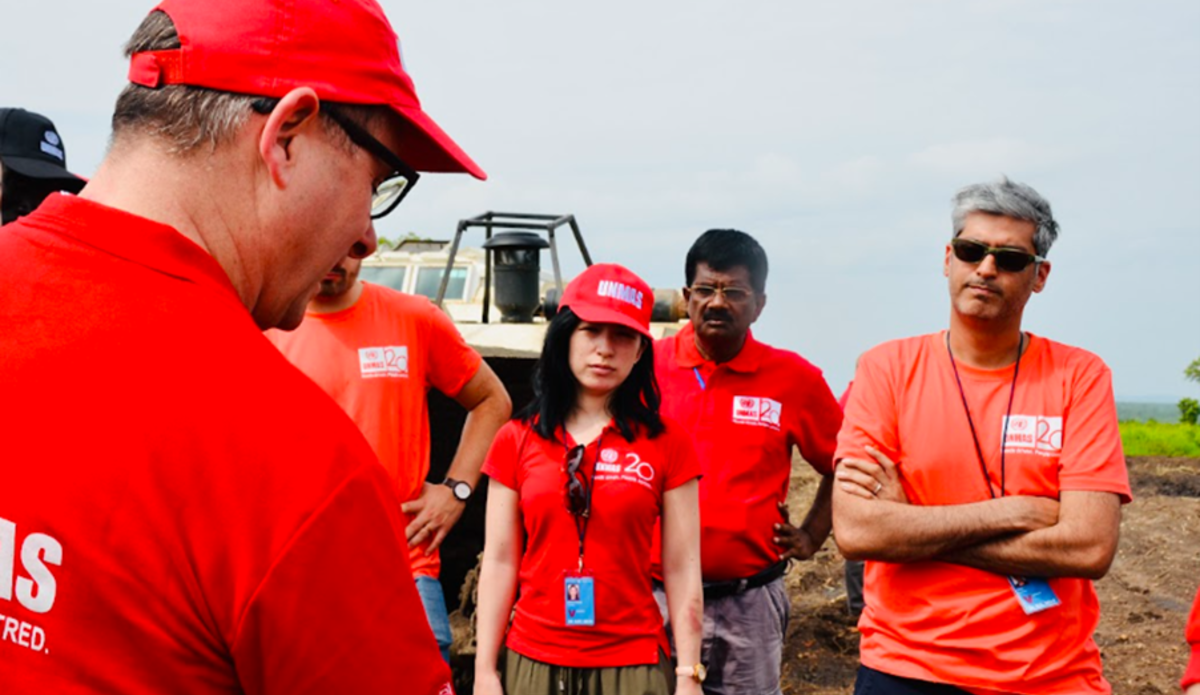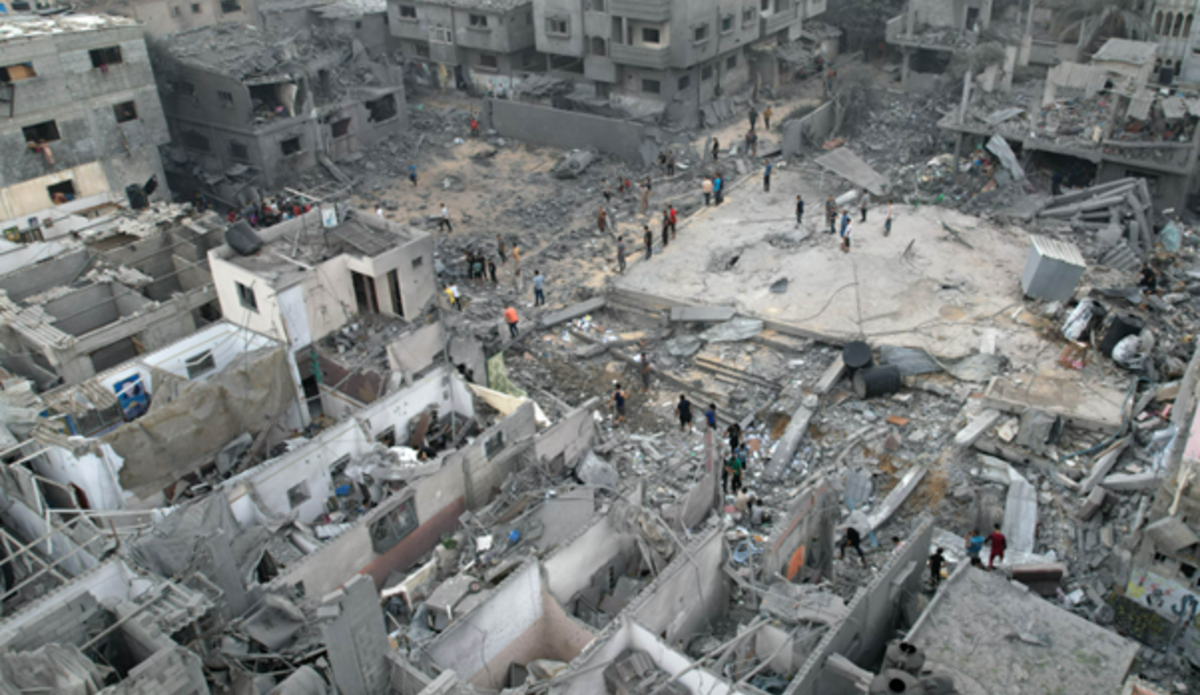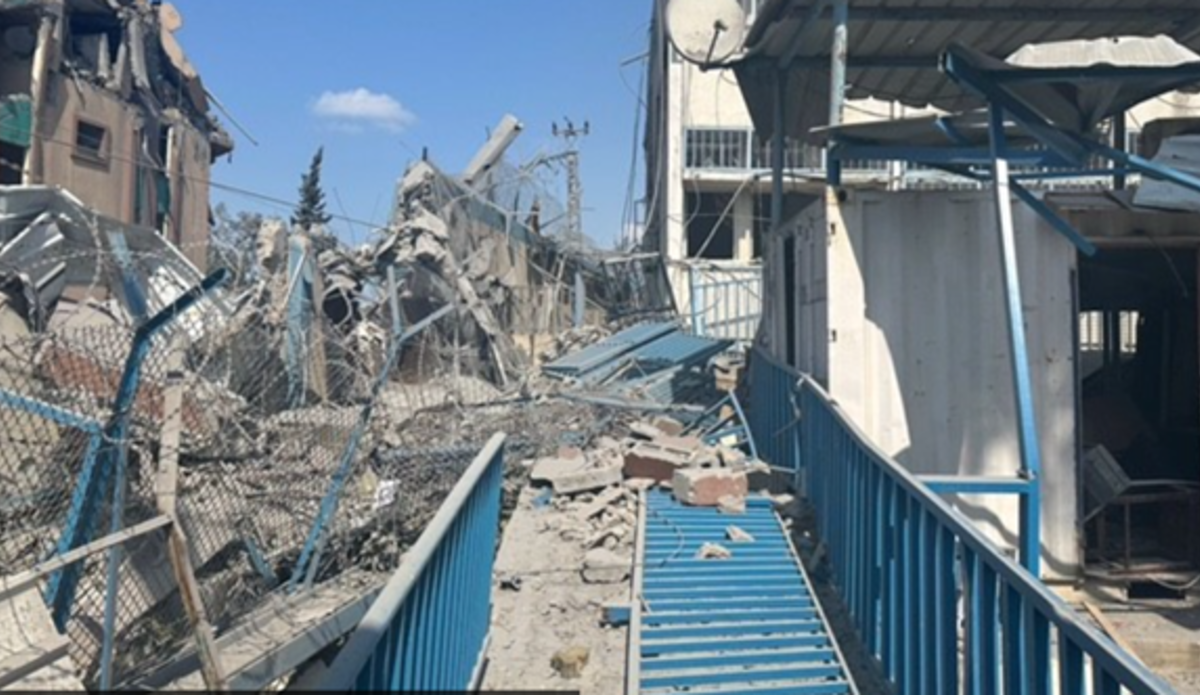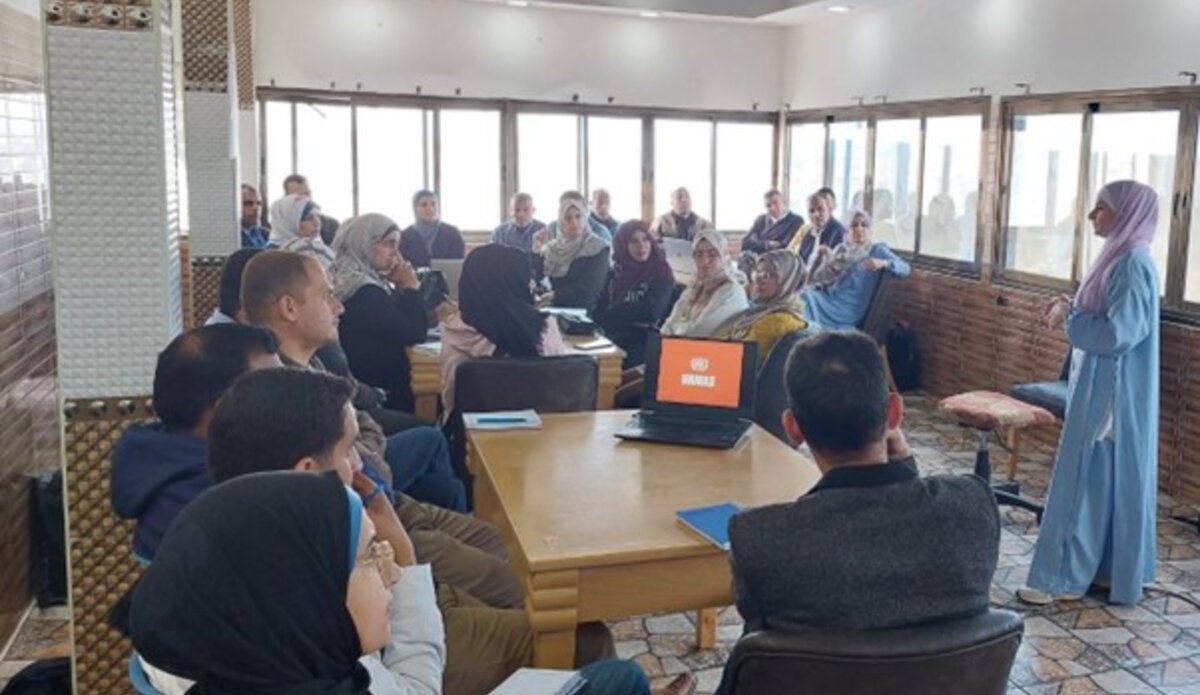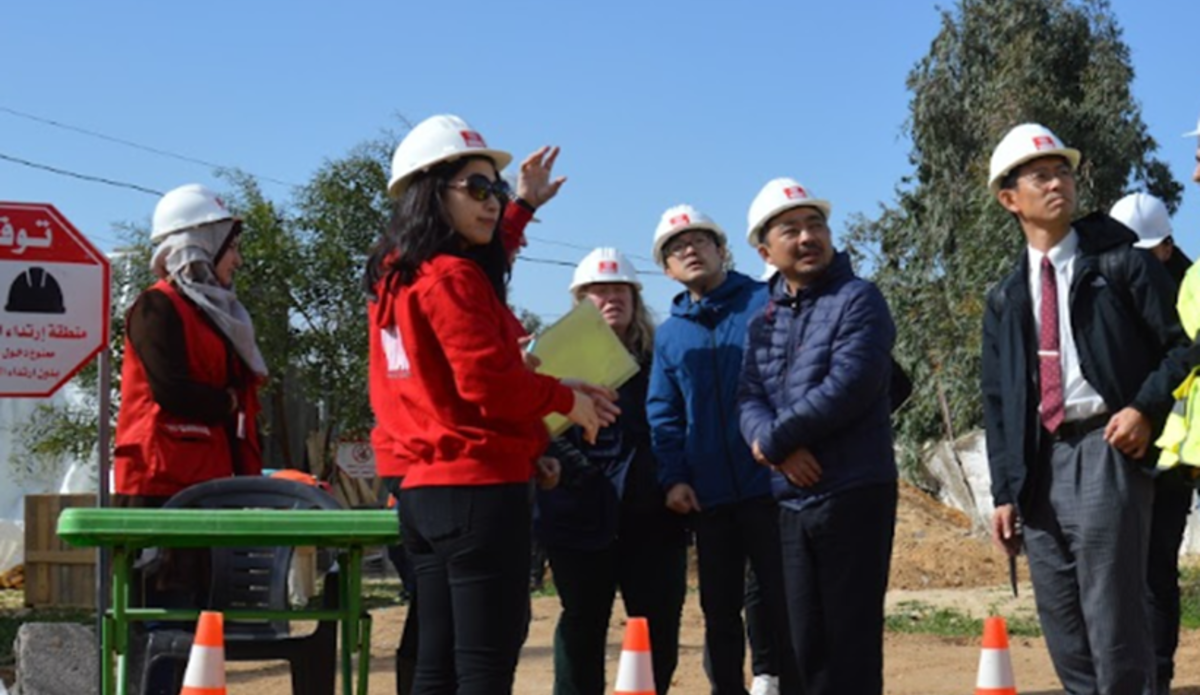Delivering humanitarian aid to the war-ravaged people of Gaza is a life-threatening task. No humanitarian aid can be delivered unless the United Nations Mine Action Service (UNMAS) assesses the risk of explosive remnants of war, and supports humanitarian convoys by avoiding dangerous routes, as it takes a long time to drive through the rubble and destroyed areas.
Japan became the first country to provide support specifically for mine action response to the issues of explosive ordnance caused by the ongoing conflict in Gaza1. Ms. Tomoko Nakayama, Programme Officer working with UNMAS Palestine, reports from the field.
A sudden large-scale conflict
On October 7, the morning after I finished a training course I was attending in Spain and connected to the Internet, I saw the first report that Hamas, an armed group controlling Gaza, had attacked Israel. The first images I saw were of damaged buildings and other structures, and fires reportedly caused by Hamas rockets, as well as the destruction of part of the military fence along the Gaza-Israel border. This time, I knew that the conflict would not last for a few days or a week, as in the past, but for months or even years. I think many people working in - or remotely for - Gaza, including myself, felt that since Hamas had not launched any major attack for some time, it would not be surprising to see some kind of armed activity from their side soon. However, we expected that any such kind of activity, if it ever happened, would be of a magnitude of the regular small exchanges of fire which had been common in the recent past. Words cannot express the shock I felt when I received the first news.
Israel has a sophisticated air defence system called “Iron Dome '', as well as fences and watchtowers along the entire border with Gaza. In the past, attacks from Gaza have mostly been with rockets fired from within Gaza, most of which have been shot down by the Iron Dome and had never successfully breached these defence systems.
Early reports at this time, however, already indicated that an attack of an unprecedented scale was underway. It was apparent that Hamas had prepared carefully, and it was expected that Israel would retaliate, which would lead to a long period of intense fighting.
Although our colleagues in Gaza were accounted for and confirmed safe, it was clear that the situation was very difficult for the local staff and for many innocent Gazan citizens who, unlike the international staff, would have great difficulty evacuating from Gaza, and it was heart-breaking to know that nothing could be done to change that.
At the same time, the images of the damage on the Israeli side, especially the Erez crossing with its multiple layers of walls and blocks that we used to pass through on our way in and out of Gaza, and the Israeli town closest to Gaza where we used to stop by, also made my heart ache with concerns for the safety of the people I knew from there and other Israeli citizens killed and injured in this conflict.
I have been working with the UNMAS Palestine Programme since 2022, after having worked at UNMAS New York headquarters and in the Nigeria Programme.
While there have been several large-scale conflicts in Gaza in the past, all the conflicts that occurred since I arrived in Gaza were smaller-scale exchanges of rockets and missiles which ended in around a week. The sounds of bombings several times a week were routine, and there were some inconveniences, such as spending several hours at a checkpoint on the way in and out of Gaza or having body and luggage rigorously searched in a separate lane at the Israeli airport. Still, compared to the Boko Haram areas in north-eastern Nigeria and South Sudan where I had been posted in the past, it was a relatively easy place to live.
In terms of work, I was supervising projects that involved safety training and the assessment and removal of explosive ordnance to protect civilians and humanitarian workers from the risk of explosive remnants of war in Gaza. At that time, there already were many problems in Palestine, especially in Gaza, where a high percentage of the population relied on the United Nations and other organizations for food, medical care, education and other things. Unexploded ordnance was also a serious problem, not only threatening people's lives and safety, but also hindering humanitarian activities, reconstruction, and industrial development.
However, the impact of the current conflict far exceeds anything seen in the past. Along with restoring access to food, medical care and education, the problem of explosive remnants of war is expected to be a serious issue for a long time to come.
Support for Gaza amid chaos
UNMAS had an office in the compound of the United Nations Relief and Works Agency for Palestinian Refugees (UNRWA), but the UNRWA compound was largely destroyed, and UNRWA schools, offices of international organizations, NGOs and other organizations were also destroyed or damaged. While the ongoing conflict required humanitarian assistance on an unprecedented scale, the activities of the United Nations, UNMAS and other organizations, were severely restricted at the start of the conflict.
The United Nations and its agencies had some stock of water, food, fuel, medicines and other essential items, but they were not at all adequately prepared for a situation like this, which no one could have foreseen. The same applies to UNMAS, which was not prepared to respond to this unprecedented situation beyond its normal needs in terms of personnel, budget and equipment.
In addition, the priority was to ensure the safety of staff, evacuate international staff, and evacuate local staff to southern Gaza. The unstable communication situation left us in a state of limbo for several weeks, with no clear picture of the situation or prospects.
Even in such circumstances, UNMAS staff, including international staff who were in Gaza at the outbreak of the conflict, did everything they could immediately after the conflict to enhance safety of the local civilians and humanitarian workers. We delivered safety messages to an estimated 1.4 million people through radio, social networking sites and cell phone messages, and by posting and distributing stickers and leaflets in shelters. We also conducted assessments of risks of explosive remnants of war at United Nations and other humanitarian partner facilities that were affected by the bombing.
From November to December, it became possible for international staff to come and go via Egypt, and the United Nations moved from a stage of doing what it could with the human resources and supplies it had available on the ground, to establishing an emergency response system. UNMAS also strengthened its efforts to protect the safety of Gaza civilians and humanitarian workers by deploying new explosive ordnance disposal (EOD) experts and returning experts who were on leave when the conflict started.
On the other hand, I personally specialise in programme management, and since returning to Gaza would put a strain on resources that were already in short supply such as security, water and food, and since being in a place with stable communications was more important than being on the ground due to the nature of my work, my duty station was changed to Amman.
My top priorities during this period were concept notes, proposals, and donor negotiations in order to secure funding for the activities that would be required. These often had very short deadlines, and being the only person in the programme management unit who could work without being directly affected by the conflict - including network issues - I had to do most of the work in the programme management unit, which meant working late into the night, even on weekends. However, I was able to get through this period thanks to the cooperation of the New York headquarters as well as the local staff, who did the best they could under the difficult circumstances they found themselves in.
Colleagues Remaining in Gaza
Like many Gaza citizens, most Palestinian employees of UNMAS have been unable to evacuate and remain in Gaza. Many have lost their homes and most of their property and have taken refuge in southern Gaza. They are working to protect other Gaza civilians from the risk of explosive ordnance while they themselves are in a very difficult situation.
The EOD operations are carried out by international staff in Gaza, and other international staff outside of Gaza, including myself, are providing project management, logistics and public relations. Local staff in Gaza are providing assistance for the international EOD experts, delivering explosive ordnance risk education (EORE) to civilians, UN and humanitarian staff, assisting project management, logistics, procurement and others. UNMAS would not be able to maintain its activities without their contributions.
One such person is Ms. Amani Abu Kalloub, who oversees EORE. Amani, too, was forced to flee her home and take refuge in southern Gaza. Amani is currently preparing to conduct training for the United Nations staff in charge of assisting displaced persons to inform them of the dangers of explosive remnants of war and how to protect themselves. She also creates and distributes posters, leaflets, and other materials, and raises the awareness of civilians on how to keep themselves safe in a contaminated environment. Amani said "We are frightened by the bombardments every day and struggle every day to secure food and necessities for our families. But we will continue our EORE to protect the lives of our citizens."
Meanwhile, there are international staff deployed from outside to Gaza, where the conflict continues. They are mainly EOD experts, since there are no local experts in Gaza equipped with the EOD skills that require advanced training, which is not available in the area. The international EOD experts, including Mr. Carlos Mesa, have been deployed to ensure the safety of the United Nations and other humanitarian organizations. Carlos reflected on this work saying "Transporting humanitarian supplies entails driving through rubble and destroyed areas, which are potentially contaminated by explosive remnants of war, for a long time, and involves high risks of explosive incidents. Therefore, no humanitarian activities can be delivered without UNMAS accompanying them, checking for unexploded ordnance and other threats, avoiding dangerous routes, and protecting humanitarian convoys. The last time we delivered medicines, water, fuel, and other supplies to a hospital in Khan Younis, southern Gaza, we were greeted with cheers by medical workers, women and children, and critically ill patients under difficult conditions. Seeing them like that makes me proud of my work."
The Severe Impact of Explosives and the Future of Gaza
My current work has gradually shifted from the stage where I was focusing almost entirely on concept notes, proposals and all the urgent tasks of the programme management unit, to one where the team has more members and has started looking at medium - to long-term planning. A project planned based on little information and unknown outcomes during an emergency will, over time, no longer be a plan that fits the current situation. In addition to the immediate needs, the needs for mine action support in the medium to long term will also be high, as explosive remnants of war will continue to threaten not only people's lives and safety, but also the safe transport and distribution of relief supplies such as water, food, medicine and fuel. UNMAS will constantly adjust its plans and implementation priorities in line with the overall United Nations policies and priorities during the ongoing conflict, immediately after the end of the conflict, and during reconstruction and development phases.
In addition, once a ceasefire is achieved, efforts will begin to remove debris and rebuild the area, and explosive remnants of war are extremely dangerous for these tasks. Currently, 1.7 million people, or 75 per cent of the population, are displaced in Gaza. Clearance and removal of explosive ordnance is essential in order to enable the displaced people to return to their homes, rebuild their homes, agriculture, livestock and commerce, as well as to enable the UN and other humanitarian organizations to deliver humanitarian and recovery assistance, and rebuild infrastructure including schools and hospitals.
UNMAS currently has international EOD experts in Gaza to accompany convoys transporting food, water, fuel, medicine, etc. for safety, to assess the risks posed by explosive ordnance at facilities of the United Nations and international organizations, to assess and record unexploded ordnance identified during the above activities, and to mark the site with danger signs or fence it off.
Additionally, UNMAS has been disseminating EORE messages via social media and radio, delivering awareness sessions for United Nations personnel and other humanitarians on risk posed by explosive hazards, placing posters with safety messages at shelters, attaching stickers to food and other distribution items, and distributing leaflets. In addition, efforts are underway to provide training to UN security personnel in convoys using routes deemed by UNMAS to be lower risk, so that they themselves can ensure the safety of the convoys.
Once a ceasefire is reached and security improves, we plan to conduct detailed and extensive surveys and to remove unexploded ordnance. Humanitarian and reconstruction assistance in Gaza is expected to continue for several years to over a decade, although the full scale of the contamination caused by explosive remnants of war will not be known until after a ceasefire and when surveys can be conducted. Given the scale of the fighting, it is expected that many explosive remnants of war will remain throughout Gaza. Large-scale survey and clearance operations are expected to be necessary, as well as capacity building for any new governing body that may be established in Gaza to conduct mine action activities on its own. Long-term support will be needed after a ceasefire is achieved.
Japan became the first country to provide support specifically for the problem of explosive remnants of war caused by the ongoing conflict. Support from other donor countries has also started to arrive. However, with no prospect of a ceasefire and the situation being difficult to assess, it will be challenging to gather much assistance.
The situation is very uncertain, but I would like to continue to contribute to mine action efforts in Gaza and Palestine as a whole.
1.Existing support from other donor countries, including the European Union and Poland, has been applied to support the ongoing situation in Gaza, and other contributions have since been received. In addition, UNMAS operations are also supported by funding through OCHA.

